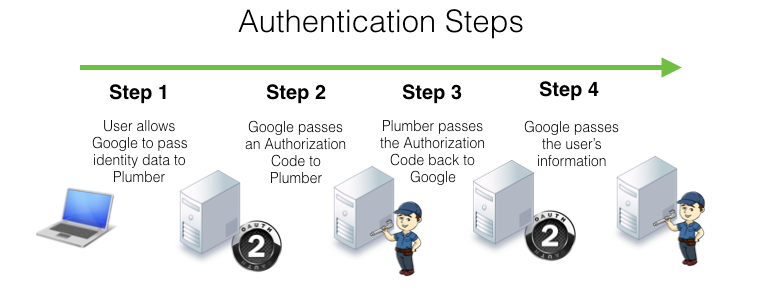The 4 Authentication Steps are encoded in the following function. The two arguments are important:
-
req - Environment variable that will contain the Google token and where we will cache the Google user's email address in Step 4
-
code - Argument unique to this process, it will contain Google's Authorization Code needed for Step 3
library(jsonlite)
library(plumber)
library(httr)
library(openssl)
identify_user <- function(req, code=""){
# Load OAuth2.0 credentials
load("creds.rds")
# Step 1 - User alllows Google to pass identity data to Plumber
if(is.null(req$session$token) & code==""){
url <-paste("https://accounts.google.com/o/oauth2/v2/auth?",
"client_id=", google_credentials$client_id,"&",
"response_type=code&",
"scope=openid%20email&",
"redirect_uri=", google_credentials$redirect_uri,"&",
"state=token", sep="")
httr::BROWSE(url)
}
# Step 2 - Google passes an Authorization Code to Plumber
if(is.null(req$session$token) & code!=""){
url <- "https://www.googleapis.com/oauth2/v4/token"
body <- list("code"=code,
"client_id"=google_credentials$client_id,
"client_secret"=google_credentials$client_secret,
"redirect_uri"=google_credentials$redirect_uri,
"grant_type"="authorization_code")
# Step 3 -Plumber passes Authorization Code back to Google
r <- POST(url, body = body, encode = "form")
r_resp <- fromJSON(content(r, "text", encoding = "ISO-8859-1"))
req$session$token <- r_resp$access_token
}
# Step 4 - Google passes the user information to Plumber
if(!is.null(req$session$token)){
r <- GET("https://www.googleapis.com/oauth2/v1/userinfo",
query=list("alt"="json", "access_token"=req$session$token))
new_resp <- content(r, "text", encoding = "ISO-8859-1")
user <- fromJSON(new_resp)
req$session$email <- user$email
return(user)
}}
#---- sample_plumber.R ----
library(plumber)
#* @get /login
function(req, code=""){
user <- identify_user(req, code)
print(paste("Welcome ", user$email))
}
#* @get /second
function(req){
if(is.null(req$session$email ))identify_user(req)
print(req$session$email)
}
library(plumber)
r <- plumb("sample_plumber.R")
r$addGlobalProcessor(sessionCookie("secret", "token"))
r$addGlobalProcessor(sessionCookie("secret", "email"))
r$run(port=1410)
cache_credentials <- function(client_id,client_secret,redirect_uri)
{
google_credentials <- data.frame(client_id=client_id,
client_secret=client_secret,
redirect_uri=redirect_uri,
stringsAsFactors = FALSE)
save(google_credentials, file="creds.rds")
}
Usage
cache_credentials(client_id = "###.apps.googleusercontent.com",
client_secret = "###",
redirect_uri = "http://localhost:1410/login")
build_url <- function(){
# Load OAuth2.0 credentials
load("creds.rds")
url <-paste("https://accounts.google.com/o/oauth2/v2/auth?",
"client_id=", google_credentials$client_id,"&",
"response_type=code&",
"scope=openid%20email&",
"redirect_uri=", google_credentials$redirect_uri,"&",
"state=token", sep="")
return(url)
}
